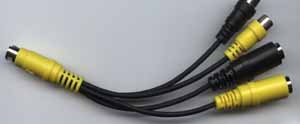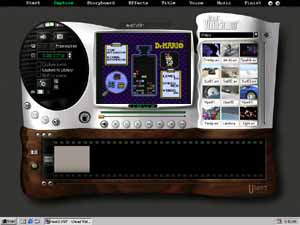Gainward CARDEXPERT GeForce3 PowerPack !!! 64MB
by Matthew Witheiler on June 14, 2001 12:04 AM EST- Posted in
- GPUs
Video Capture
In the past, special designs such as the ones implemented in the ASUS Deluxe series cards were needed if VIVO functions were desired on an NVIDIA card. The launch of the GeForce2 GTS and its "daughter card" feature promised to bring full VIVO functionality to NVIDIA cards, but in reality we only saw manufacturers use the card for TV-out features. It seems that the GeForce3 product line finally allowed for a VIVO daughter card to be implemented.
The CARDEXPERT GeForce3 PowerPack !!! uses a universal dongle of sorts that breaks up into an S-Video out connection, a composite out connection, an S-Video in connection, and a composite in connection. All are conveniently color coded, with the yellow wires indicating video-in connections and the black ones indicating video-out. The single card connection is necessary to make space for the DVI port also located on the back of the card.

We were quite pleased to finally find a VIVO daughter card and were surprised at its small size. In the past, cards like the ASUS Deluxe cards required two separate chips in order to supply both video-out and video-in. The Philips SAA7108E combines both of these functions onto one chip, meaning that the daughter card consists only of the SAA7108E and some filters, 2 crystals, and resistors.
Driving the video-input features of the CARDEXPERT GeForce3 PowerPack !!! on the software side is Ulead Video Studio 5.0. We have seen previous incarnations of this video editing package before and complained at its difficult use. Luckily, the new version made some needed changes.
After installing Video Studio and the appropriate drivers, we were greeted with the Video Studio main screen. We quickly found our way around, opting to produce a new capture file. The software allows for the capture to be saved in a variety of outputs including MPEG2 and AVI. Both of these formats, which we suspect will be the most used ones, allow capture resolutions up to 720x576. We hooked up our trusty NES to the composite input of the CARDEXPERT GeForce3 PowerPack !!! and were presented with the following screen.
From here, Video Studio 5.0 made video capture easy. Video could be recorded and still images could be captured with the click of a button. This was one area that we had problems with in the past, but it seems that version 5.0 makes it easier. Transition effects, like those shown below, were easy to add between images or segments of video.
Finally, audio can be recorded, text added, and the final project saved in just a few steps.
Although Video Studio has become the standard bundled video capture software, we would have liked the VIVO features of the CARDEXPERT GeForce3 PowerPack !!! better if it came with a simple, stripped down capture utility as well. We found that with our ASUS Deluxe cards, it was often easier to capture video with the ASUS utilities than it was with Ulead Video Studio, especially when the capture did not need to be professionally edited or altered.
When all was said and done, the capture quality was on par with other VIVO systems we have looked at.












0 Comments
View All Comments